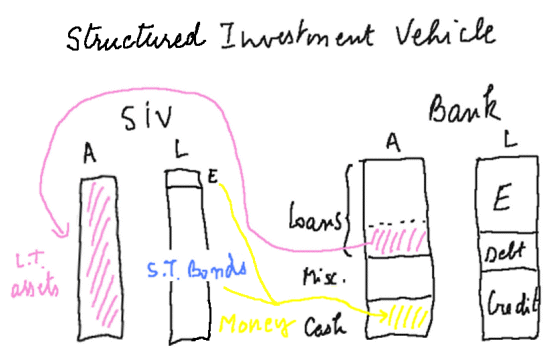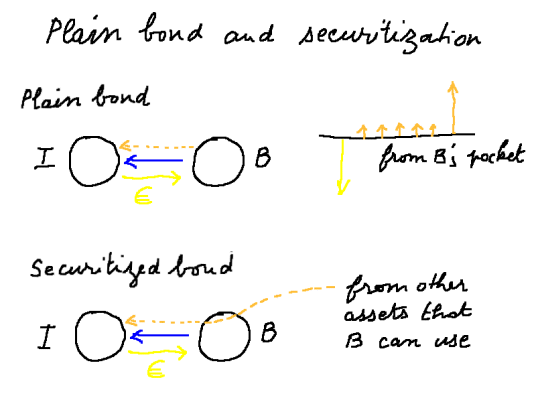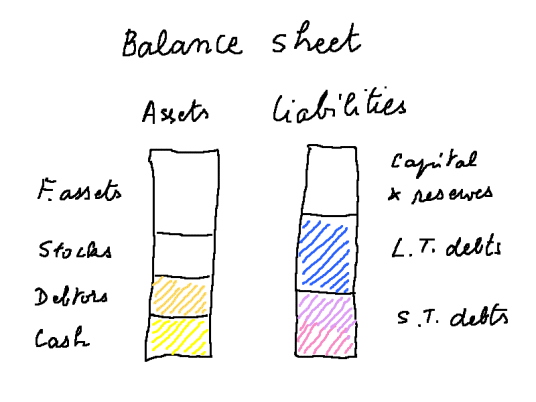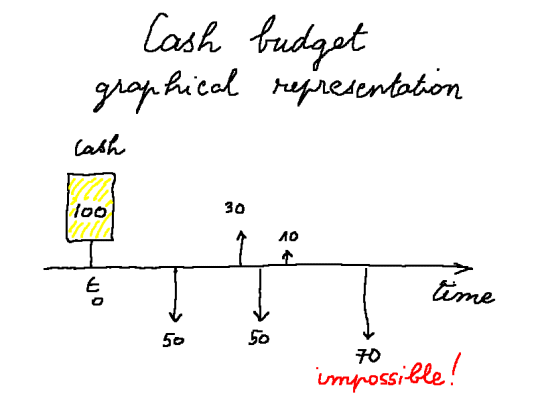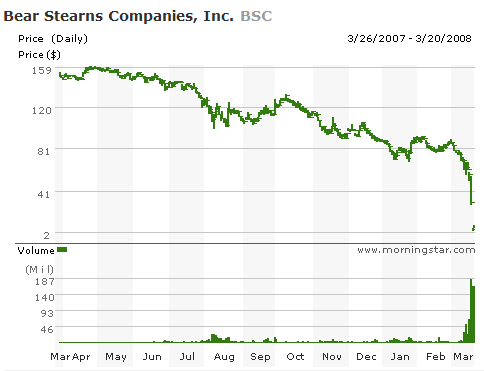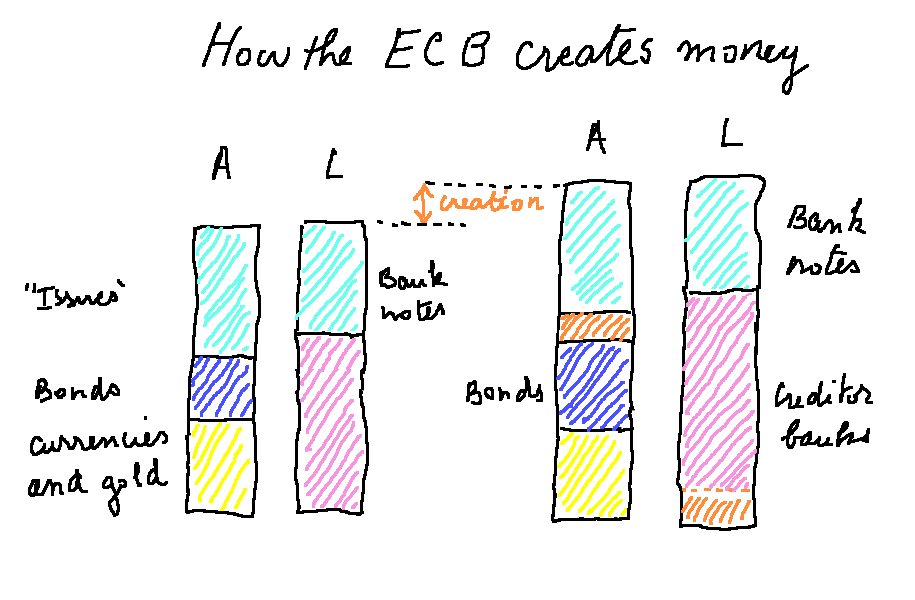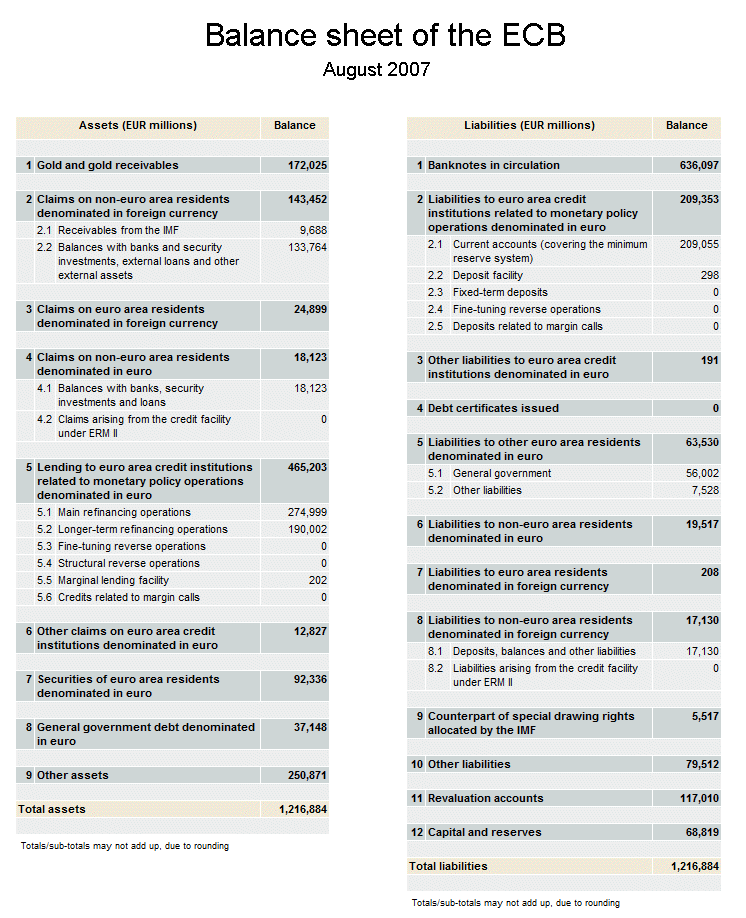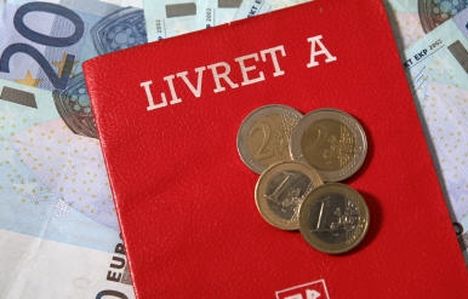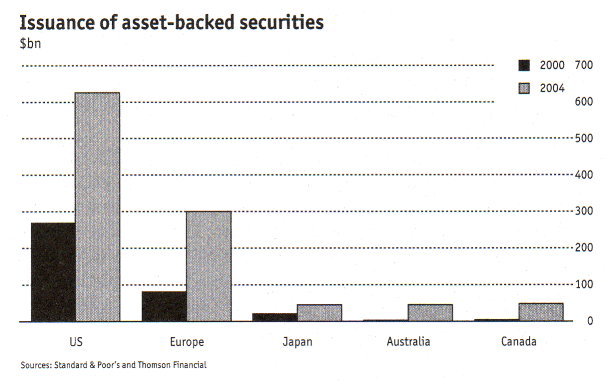Advanced financeLesson 5: Securitisation
In order to understand what is a bond created by securitization of initial financial products, we must ask ourselves: "who will pay the interests and principal of the securitized bond?"
To make a securitization of "primary assets" held in the balance sheet of a financial institution, a Structured Investment Vehicle (SIV) is created (see picture on top of page). The SIV issues new bonds (the asset-backed securities), to raise cash, and the cash is used to buy the "primary assets" (which are also the backing assets). Reading this chapter, it will become clear that "securitized" bonds are not much different from equity (leaving aside the notion of ownership): they are securities providing future unsure cash flows, related to some venture.
What is a bail out? Since the present "subprime crisis" in the United States leads to many bail outs of large financial firms (like Bear Stearns in mid march 2008), we insert a brief subchapter on bail outs. What leads to the situation where a bail out is being considered? Answer: a forecast bankruptcy. A firm, be it industrial, commercial or financial, is in a state of bankruptcy when it cannot make cash payments that are due now. That is, the firm ran out of cash and for a variety of reasons cannot get or raise short term cash, and yet desperately needs it. A firm is a dynamic entity, by which we mean "an entity evolving over time", with various processes going on:
The record of movements of value (in and out) over a period of time [t1, t2] is called the income statement of the firm during that period. (This cursory description does not purports to explain accounting in detail, but to give the reader a bird's eye view of accounting and of cash. For a detailed presentation of accounting we invite the reader to go to our introductory course in accounting and finance.) At any date t it is possible to establish a balance sheet: it is the list of all the assets the firm owns, and all the liabilities the firm has. By its very construction, the assets and liabilities sides of a balance sheet must be equal. One item is very important on the asset side, it is the cash.
Above is presented the balance sheet of an industrial firm, but for any firm (industrial, commercial, or financial) the notion of liquidity is the same. At any time t, the firm must have enough liquidity to make the payments due at time t. Cash budget: it is a short term forecast of the cash outlays and cash inflows.
In the above example, if the firm has 100 (thousand euros) at time t0 and is forecasting the five flows shown above (three outlays and two receipts), we see that it will not be able to make the third payment, because it requires a cash outlay of 70 but there will only be 40 in the till. In this case, either the firm can obtain more cash, one way or another, or it cannot. There are several ways to obtain more cash:
At any rate the firm needs cash. The interesting point here is that cash is only a sign that the firm is healthy, that the community trusts it. And the impossibility to get more cash is the sign that the firm is not longer trusted, has no more credit.
Bankruptcy If the firm can definitely not find the cash needed, it is bankrupt. Formally, it "files for banruptcy", that is it warns the business authorities from which it depends that it cannot make a payment due. (In the United State, there is a similar procedure where the firm "goes under the protection of chapter 11", which means that the firm asks for a temporary freeze of all its liabilities to creditors.) The authorities study the situation and may decide either of the following:
In a bail out, who pays what to whom? In a bail out, new investors bring "fresh money" to the firm in difficulty. This can be done, technically, via the purchase of new bonds or new shares of stock issued by the firm (which can be a plain acquisition). Anyhow, in practice the new investors usually become the new controlling owners of the firm. The previous owners are left with a small percentage of the new capital. This happened for instance to the owners of Bear Stearns. At the beginning of March 2008, Bear Stearns had a market value of $10 billion, or equivalently was worth a bit more than $80 a share, but on March 16, 2008, JP Morgan Chase bought Bear Stearns for $236 million, that is $2 a share, which made the old shareholders angry. In fact, on monday March 24, JPMorgan was mentioning the possibility to raise the price it paid to $10 per share. Would it be necessay to some, this shows that we are quite outside the concepts of "financial markets", "supply and demand", "price formation", etc. (And the SEC is investigating suspicious transactions around the deal.)
Source: morningstar
With which money? JP Morgan Chase gave value to the old owners of Bear Stearns. The operation was done via a stock swap, that is the old owners, instead of receiving cash, received shares of JP Morgan Chase. But JP Morgan Chase also injected money into its new acquisition to help it face its forthcoming payments due. For this purpose, the Federal Reserve lent $30 billion to JP Morgan Chase to cover losses from Bear Stearns' investments in mortgage-backed securities and more exotic investment paper. Example of exotic paper: you are a stock market player and you sell, at time t, for some cash, to another agent the right to buy from you, at time T (later than t) some stock S at a price E. You do that because you think that, at time T, the market price of S will be less than E, and therefore the other agent will not exercise its right. But if you turn out to be wrong, and at time T the price of S is higher than E, you are in trouble: you will have to buy S on the market and sell it to the other agent at price E. The financial contract you sold to the other agent is called a call option. It is a derivative (S is the underlying asset, E the exercise price, T the exercise date) and it is not considered particularly exotic yet. When we study options, we shall make use of the functions
Usually professional agents who sell such derivatives cover themselves by buying, at the same time t, similar products, for instance a call option at a price E' a little higher than E. Therefore if things go bad, the loss will be limited.
The bail out of Bear Stearns by JPMorgan (which hides the bail out of JPMorgan by the Fed, like the finger hides the Concord obelisk) made the political, financial and academic communities express reserves:
With which money (con'd)? It is important to understand that a banking system (each bank, and primarily the central bank) can create money. The European Central Bank creates €100 billion of new central bank money by adding an entry €100 billion on the asset side of its balance sheet, and adding €100 billion of credit to the banks creditors to it.
Illlustration: general principle of money creation by the central bank Then, the secondary banks, having more reserves at the central bank, can in turn create money in the usual way.
Here is the "consolidated balance sheet of the Eurosystem":
Source: https://www.ecb.int/press/pr/wfs/2008/html/fs080318.en.html
More information can be found on the site of the ECB. Here is the aggreaget related balance sheet of all euro financial institutions (excluding the Eurosystem):
Source: https://www.ecb.int/stats/money/aggregates/bsheets/html/outstanding_amounts_2008-01.en.html
Some famous past bail outs In 1998, the Fed organized the bail out of LTCM. It required the participating banks to put up front $3.6 billion into the fund. In the end the losses incurred by all the players were about $4 billion. Extract from wikipedia's article on LTCM:
Goldman Sachs, AIG and Berkshire Hathaway offered then to buy out the fund's partners for $250 million, to inject $4 billion and to operate LTCM within Goldman Sachs's own trading. The offer was rejected and the same day the Federal Reserve Bank of New York organized a bail out of $3.625 billion by the major creditors to avoid a wider collapse in the financial markets. The contributions from the various institutions were as follows: [2] [3]
In return, the participating banks got a 90% share in the fund and a promise that a supervisory board would be established. The fear was that there would be a chain reaction as the company liquidated its securities to cover its debt, leading to a drop in prices, which would force other companies to liquidate their own debt creating a vicious cycle. In the 1980's the United States bailed out a part of its Savings and Loans financial institutions. It also bailed out, with public money, the Continental Illinois National Bank, and the auto manufacturer Chrysler. March 24, 2008, the Fed and the federal government of the United States are considering buying back the entire bad mortgage-backed bonds, a radical solution which would cost between $2 and 3 trillions, but may be the best way to avoid a general collapse of the US financial markets.
What is the debate/controversy about bail outs? Public money is used to save private interests. When the private interests ventures are profitable the profits do not accrue to the community at large. But when the ventures go bust and public money is used to bail them out, the community at large uses its resources to save the private interests. Notice that "the resources of the community" is not exactly what common sense suggests. It is not "money belonging to the communitiy" that is used here instead of elsewhere - not quite. First of all, money is created (or removed) at will by the monetary authorities. Secondly, it is not an allocation of money here instead of there. But it is new liabilities of the community at large created to help the private interests face the liabilities which they could no longer handle alone.
Should the central banks "save" failing financial institutions? In which cases? The real question is: "What are the opions? And what are the consequences of each of them?" In theory, the monetary authorities step in (like the Fed did when it lent $30 billion to JPMorgan a few days ago) when the alternative is dire consequences for the whole community. Indeed, to let Bear Stearns default for good on its liabilities would create a domino effect. Many other institutions would have to withstand the default from Bear Stearns. This would lead many banks and financial institutions to bankruptcy. And in the end it would probably let the whole US financial system auto-destroy itself.
What are the alternatives? The question is not so much: "Should the Fed have stepped in or not?" Indeed the alternative now is unacceptable. The question is: "What should the Fed require from the financial institutions when things go well?" There should be, say the advocates of alternative methods, a sort of insurance system much more important and stringent than today's system, requiring all the financial institutions to participate in a bail out fund of one sort or another. Others just claim: "The financial system should be much more regulated", "It should be a public institution under the democratic control of the people".
Ideas to think: It is the view of the teacher that, in each monetary zone, the authorities should let exist in parallel a regulated financial system and a free financial system. It would be understood that the free financial system would never be bailed out. The present problem with bail outs is that, in western countries, many modest people who put their savings or their credit account in big reputable banks (like Crédit Lyonnais) weren't aware that they actually took part in a casino-free-for-all binge and that their savings were at risk. It is because the Amercian S&L financed themselves on the free financial markets that they ended up, in the early eighties, needing a big bail out. In France "le livret A" paid much less than safe rates offered on the free market, but it never needed a bail out. And it efficiently served to finance housing construction.
French Livret A
Securitization (Levinson, chapter 5) "Plain vanilla" bonds are the simplest kind of financial contract structuring the borrowing and refund of money from B to A (B is the borrower and A is the lender). They present the advantage for A and for B that all the dates and amount of future payments of interest and the final redeeming are specified at the issuance of the bond, and aside from the risk that B defaults there is no other randomness. A bond produced by the process called securitisation is another type of financial contract. It is called an asset-backed security because the future payments to the lender will come from a stream of income the issuer expects to receive in the future from other assets. These are not specified with fixed dates and amounts like those of a plain vanilla bond. Most often the issuer of the ABS is not ultimately responsible for the good payments to the lender. The lender's future incomes depends on how the backing assets will perform. These future cash flows show a large degree of randomness: they may last less than initially expected, or they may last longer. We will see that when we construct an elaborate collection of bonds from the future cash flows of the ABS, like we did in the process of constructing STRIPS, we produce bonds with quite different characteristics in terms of yield and risk. ABS are sold with either fixed rates of interest or with floating rates. They come into two big categories:
In the United States, mortgage-backed securities account for approximately 75% of the ABS outstanding. In the 25% non-mortgage category we find: auto loans, credit-card loans, home-equity loans, manufactured housing loans, students loans, equipment loans, and others. Below are statistics for the total US bond market:
The column "Mortgage Related" includes the ABS backed by mortages. The column "Asset-Backed" comprises the ABS resting on other assets than mortgages.
Securitization process "Securitization is the process by which individual assets, which on their own may be difficult to sell or even to attach a value to, are aggregated into securities that can be sold in the financial markets." (Levinson, p. 95) In many cases, investors in an asset-backed trust benefit from certain guarantees. Governments frequently guarantee part or all of the payment fon residential mortgages to encourage housing construction.
Why securitize?
Source: Levinson, p98
Mortgage-backed securities Fannie Mae The Danes are credited with the invention of mortgage-backed bonds to finance entities, themselves financing housing. In France, the first government sponsored initiative to help housing construction is the "Loi Loucheur" of 1928. The public circuits of money to finance housing, in France, have unfortunately quickly become very opaque and served to finance political parties. Not devoid of humour, the main Parisian such agency is called the "Office Public d'Aménagement et de Construction de Paris" (OPAC). "Fannie Mae" is the endearing nickname Americans give to a financial institution whose official name is "Federal National Mortgage Association" (FNMA). It was created, as a federal agency, in 1938 in order to create a secondary market in mortgages. "The primary mortgage market involved the decision by a private company, known as the originator, to lend to a home buyer. When it purchased such a loan from the originator in the secondary market, Fannie Mae made it possible for the originator to make yet more loans, providing a substantial impetus to the housing market. With Fannie Mae as a model, private-sector entities began to purchase individual mortgages in secondary-market transactions as early as 1949, and US government regulators formally permitted thrift institutions to buy and sell mortgages in 1957." (Levinson, p.99) In 1968, Fannie Mae was rechartered by Congress as a shareholder-owned company, funded solely with private capital raised from investors on Wall Street and around the world.
From its outset, Fannie Mae established standard procedures to be used in originating the mortgages it would buy, including methods of valuing property, rules for assessing individual borrowers' creditworthiness, and rules relating mortgage eligibility to income. It also set rules to govern servicing, the collection of interest and principal payments from borrowers, which most often was handled by the originator. Such standards eventually smoothed the development of mortgage-backed securites: although each mortgage backing a particular security would be different in detail, investors could be assured that every individual mortgage complied with the same general standards.
Pass-through certificates Initially, Fannie Mae used government money to purchase mortgages from lenders that had originated them, with the interest payments on the mortgages serving to repay the government. Then, in the 1960's, investment bankers hit upon and idea for tapping private investment by turning mortgages into securities, rather than buying and selling individual mortgages. These new securities were called pass-through certificates, so named because the principal and interest due monthly from the mortgagors of the loans backing the security would be passed directly to the investors. Pass-throughs, first issued in 1970, were the first modern asset-backed securities.
CMBS Commercial mortgage-backed securities: the backing securities may be mortgages for apartment buildings, housing for elderly, retail developments, warehouses, hotels, office buildings and other sorts of structures. (See Levinson, p. 100, for details.)
REMICs Real Estate Mortgage Investment Conduit: a legal device, conceived in 1986, to ensure that the income produced by a mortgage-backed security is taxable to the investors who have purchased the securities, but not to the trust that nominally owns the underlying mortgages and collects the payments from individual mortgagors. Many mortgage-backed securities in the United States are now issued through REMICs.
US agency securities Several entities sponsored by the US government are authorised to promote secondary markets for mortgage-backed securities.
Fannie Maes Name given to the securities issued by Fannie Mae
Other similar agencies Ginnie Mae: Government National Mortgage Association (GNMA). It is a split off from Fannie Mae in 1968, and benefits from stronger government guarantees. Freddie Mac: Federal Home Loan Mortgage Corporation (FHLMC). Farmer Mac: Federal Agriculture Mortgage Credit Corporation (FAMCC).
Non-mortgage securities
Asset-backed commercial paper Assets supporting medium-term and long-term paper can also be used to back commercial paper.
Structured finance Once a ABS has been created, it can be "stripped" like STRIPS do for Treasuries. The best known are CMOs (collateralized mortgage obligations). To create structured securities, the issuer divides the securities backed by a pool into sections, called tranches or classes, with different characteristics. One CMO created from a mortgage-backed security, for example, might consist of all principal and interest payments received during the first three years. A second tranche might consists of payments received in years 4 to 7, and so on. The last tranche bears the evocative name of "toxic waste".
Like STRIPS, CMOs main role is to guarantee the liquidiy of markets with products adjusted to any kind of risks the investor is looking for.
Go to lesson 6 | |||||||||||||||||||||||||||||||||||||||||||||||||||||||||||||||||||||||||||||||||||||||||||||||||||||||||||||||||||||||||||||||||||||||||||||||||||||||||||||||||||||||||||||||||||||||||||||||||||||||||||||||||||||||||||||||||||||||||||||||||||||||||||||||||||||||||||||||||||||||||||||||||||||||||||||||||||||||||||||||||||||||||||||||||||||||||||||||||||||||||||||||||||||||||||||||||||||||||||||||||||||||||||||||||||||||||||||||||||||||||||||||||||||||||||||||||||||||||||||||||||||||||||||||||||||||||||||||||||||||||||||||||||||||||||||||||||||||||||||||||||||||||||||||||||||||||||||||||||||||||||||||||||||||||||||||||||||||||||||||||||||||||||||||||||||||||||||||||||||||||||||||||||||||||||||||||||||||||||||||||||||||||||||||||||||||||||||||||||||||||||||||||||||||||||||||||||||||||||||||||||||||||||||||||||||||||||||||||||||||||||||||||||||||||||||||||||||||||||||||||||||||||||||||||||||||||||||||||||
